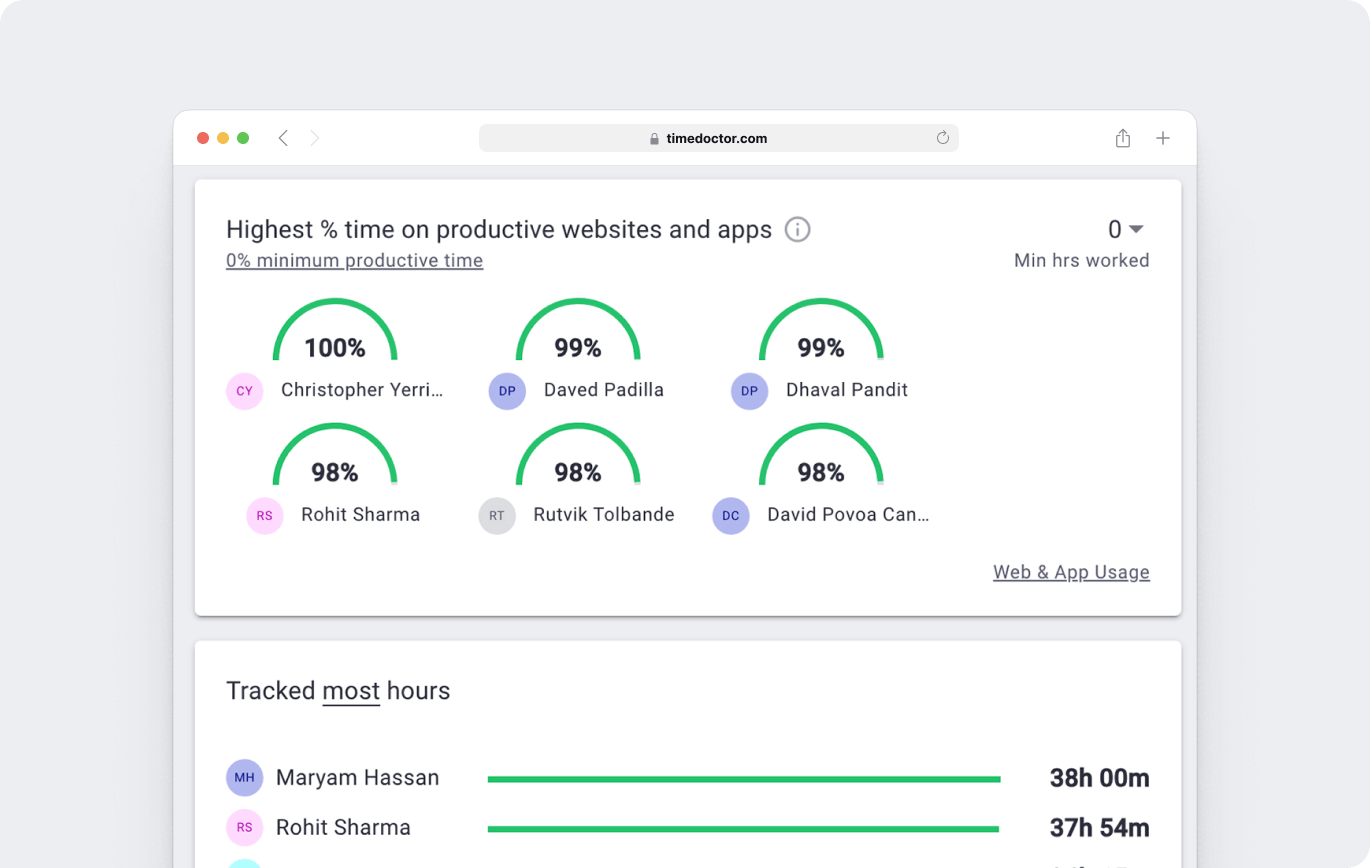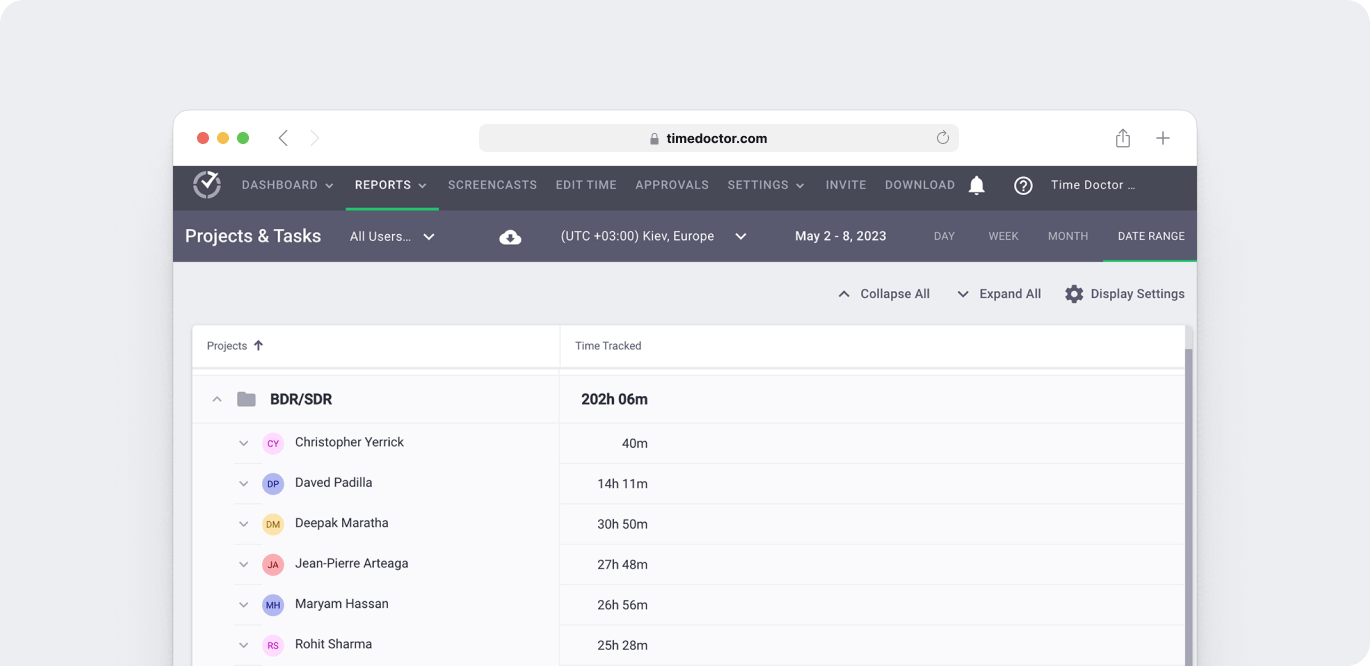226
Are you tracking the right workforce metrics to truly understand and boost your team’s productivity?
Having accurate data is now essential for companies wanting to improve efficiency, prevent burnout, and make smart decisions that drive growth. By focusing on key workforce metrics, you can better support your team, boost employee engagement, and make choices that drive your company’s success.
Time Doctor helps companies track important workforce metrics in real-time. It collects data on when employees are active or inactive, the apps and websites they use, and overall productivity patterns. With easy-to-read dashboards and reports, managers can gain clear insights to make informed decisions. Below, we’ll look at the key metrics that show how teams work and where there’s room for improvement.
Table of Contents
Why workforce analytics metrics matter
Tracking the right workforce analytics metrics can help companies enhance workforce management and drive employee performance. These metrics go beyond traditional HR metrics by providing insights that help companies improve workforce planning, optimize employee engagement, and retain top talent.
With Time Doctor’s tracking features, businesses can access data to understand workforce dynamics, address challenges, and improve team performance.
Research shows that companies leveraging HR analytics are more likely to foster environments with high employee engagement and satisfaction scores. For instance, by analyzing workforce data, organizations have pinpointed critical factors in employee satisfaction and implemented targeted programs that increase retention and engagement rates.
Let’s look at the essential workforce analytics metrics every company should monitor.
4 essential workforce analytics metrics to track using Time Doctor
1. Productivity metrics
Productivity is one of the most important workforce analytics metrics, directly impacting a company’s bottom line. Productivity metrics measure how effectively employees spend their time on tasks, providing a snapshot of how work is distributed and completed.
By understanding productivity patterns, companies can identify areas where efficiency might be improved, such as reallocating resources or identifying specific times when productivity is highest. Time Doctor’s productivity tracking tools give managers a clear view of work hours, helping them pinpoint productive and unproductive patterns. This workforce data is essential for effective resource allocation and ensuring that teams work at their best.

2. Employee engagement and focus levels
Employee engagement reflects how committed and enthusiastic employees are about their work, which can significantly impact morale, productivity, and retention. High engagement correlates with higher quality work and less turnover, positively affecting retention. Tracking engagement also helps identify burnout risks so that managers can provide support early.
Time Doctor’s real-time tracking features capture focus levels by showing periods of high engagement throughout the day. This insight allows companies to create targeted support strategies that enhance productivity and well-being.
For example, if engagement consistently dips in the afternoons, management could implement short breaks or wellness activities during this time.

3. Time utilization rates
Time utilization measures the percentage of an employee’s time spent on work-related tasks. This metric is essential for workforce planning metrics, as it reveals how effectively resources are used and highlights issues with overwork or underutilization.
Using Time Doctor, managers can monitor time utilization across teams, making it easy to spot workload imbalances.
For example, if one team consistently has a higher workload while another is underutilized, it could indicate that resources need reallocation. Properly tracking and managing time utilization helps prevent burnout and ensures every team member effectively contributes to the company’s goals.
4. Absenteeism and availability
Absenteeism is a key metric for understanding workforce health and attendance patterns. High absenteeism can signal disengagement, workplace dissatisfaction, or personal challenges impacting employee well-being. When absenteeism becomes frequent, it can hurt productivity, morale, and customer satisfaction.
Time Doctor provides insights into active and inactive times, giving managers a clear view of attendance patterns. This proactive approach allows companies to address attendance issues before they escalate, enabling management to understand the factors affecting absenteeism.
For example, managers may find that employees in a particular role have higher absence rates due to burnout, which may prompt adjustments to workload or schedule flexibility.
New to workforce analytics? Check out our guide: What is workforce analytics? A clear and simple guide. This guide covers workforce analytics basics, key benefits, and differences from traditional HR metrics, helping you understand and implement workforce analytics.

2 advanced workforce analytics metrics with Time Doctor
1. Turnover rate & retention insights
The employee turnover and retention rates provide insights into workforce stability and employee satisfaction, both essential for planning and growth. Monitoring these metrics allows businesses to see why employees may be leaving and identify any patterns, such as turnover due to burnout or lack of engagement.
Time Doctor’s data helps managers see patterns that could signal turnover risks. For example, if specific departments have a consistently high turnover rate, it might indicate a need for additional support or management changes. Retention insights also allow companies to improve retention through targeted support, training programs, and other workforce management strategies. With a data-driven approach, managers can secure their workforce and build a foundation for future growth.
2. Internal mobility and skill utilization
Internal mobility, or the ability for employees to move laterally or advance within a company, is a key indicator of how effectively an organization uses its talent. Tracking internal mobility helps identify high-potential employees who may be ready to take on new roles or develop their skills further, supporting employee growth and fostering a skilled, resilient team.
Time Doctor’s reporting tools provide insights into employee performance and skill usage, helping companies identify employees ready for advancement. This workforce data can be used in decision-making for succession planning, training investments, and skill development initiatives. By supporting internal growth, companies can create a more robust workforce and reduce the need for external hires.
Leveraging metrics for strategic decisions
With Time Doctor’s human resources dashboards and real-time workforce analytics metrics, companies can turn data into actionable insights. Consistently tracking these metrics allows managers to make informed decisions about resource allocation, project timelines, and employee support. Using data to guide workforce management can reduce burnout, increase productivity, and keep employees engaged.
Examples of actionable insights from Time Doctor include identifying under-resourced teams by analyzing workload distribution and productivity levels. The tool tracks time spent on tasks, revealing which teams may be overloaded based on consistently high work hours or unmet deadlines. This data helps managers spot imbalances and make necessary adjustments, such as reallocating resources or hiring additional staff.
Time Doctor also detects patterns of disengagement by monitoring employee activity levels, focus times, and time spent on productive versus non-productive activities. If employees frequently disengage (e.g., with extended periods of inactivity or low productivity scores), it could signal burnout or low engagement.
Early identification allows managers to address these issues by adjusting workloads, providing support, or offering new growth opportunities.
Time Doctor is especially helpful for remote teams in identifying patterns that may indicate isolation or disengagement. It allows managers to support remote employees through regular check-ins, team-building activities, and flexible working options.
Conclusion
Tracking the right workforce analytics metrics is essential for maximizing productivity and building an engaged, efficient team. With Time Doctor, companies can access real-time insights that simplify workforce management, improve team performance, and help achieve strategic goals. Consistently monitoring these metrics empowers managers to make decisions that benefit employees and the business.
Are you ready to take a closer look at your team’s productivity? Which metrics could reveal new insights to enhance your workforce strategy?

Liam Martin is a serial entrepreneur, co-founder of Time Doctor, Staff.com, and the Running Remote Conference, and author of the Wall Street Journal bestseller, “Running Remote.” He advocates for remote work and helps businesses optimize their remote teams.


